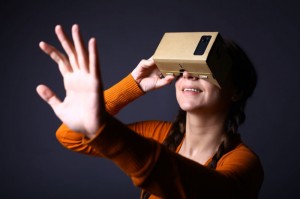This week’s new leap across media boundaries is an Evel Knievel-sized jump. The New York Times is moving into virtual reality storytelling. I don’t know about you, but I’m both floored and not the least bit surprised.
For a while, I’ve been talking about how the walls dividing the three traditional types of media – audiovisual (television, film), audio only (radio, music, audiobooks), and print – are collapsing. It’s an inevitable part of The Jetsons Future, where all content is delivered via broadband, rather than broadcast or print.
With that, the words of Marshall McLuhan come into play: the medium is the message. In other words, when you deliver content through an entirely new means, the content itself must inexorably change.
One of the leading changes is media convergence, where audiovisual, audio-only, and print become one.
Print journalists are now appearing as television and radio talent with greater frequency than ever before. Radio stations – at least the ones with budgets for it – now produce copious amounts of video and printed content (as in blogs) that they distribute online. Television journalists now write print content for websites, while the biggest scripted show in television has a print element to it every week that was notable enough that it spawned a book.
Media convergence even led the biggest radio operator in the U.S. to change its name, sending an incredibly important message to talent in the process.
The lessons?
- If you’re talent, you’d better broaden your horizons beyond your primary performance medium. Whatever your primary skill set, you need to develop at least serviceable skills across all three media forms.
- If you’re an entertainment company, you’d better assemble talent that can create content across all media forms. This is not the time to divest yourself of seemingly incompatible assets. It’s the time to realize that those assets are not just compatible, they’re complementary (and necessary).
This is the time to experiment, to look for new ways to do new things – not in place of what you’ve always done, but in addition to what you’ve always done. I’ve praised The Gray Lady before for constant experimentation; they do more of it than just about anybody else in media or entertainment. They’ve been making documentary films for a while, but moving on to V.R? You expect Facebook to be working on virtual reality, but an old-line print purveyor? That should tell you plenty about how much – and how quickly – things continue to change.
Now, to fully consume your newspaper, you don’t just need a digital device. You also need a cardboard viewer. Weird, I know, but that’s the whole point:
These are weird times, and you can’t expect to be successful by doing the “normal” thing.
Here’s something interesting that Time Warner CEO Jeff Bewkes said on this week’s earnings call: “Having great content is no longer enough. Content has become just one element of the broader consumer experience. And while we are living in the golden age of television programming, for many consumers the television viewing experience is stuck in the Bronze Age, so we’re stepping up our investment and providing the best possible consumer experience . . . That includes new broadband-delivered initiatives targeted to Millenials such as HBO NOW, CNN start-up Great Big Story, and TBS’s new digital studio, Super Deluxe. It also includes investments like Turner’s majority stake in iStreamPlanet, a leading platform for live streaming.”
So the New York Times has great content, and it’s investing in making more and different kinds of great content, plus the technology to go with it. (Side note: the technology includes new apps…and a piece of cardboard. Like I said, these are weird times.) Time Warner, with lots of content, is focusing on all sorts of fascinating new methods of distribution. Of content and distribution technology, you know which is more important to develop right now, don’t you?
Yep, both of them.
And if you’re talent, while you almost certainly can’t develop the technology yourself, you can look for ways to align yourself with it. That’s what Adam Carolla just did.
More important, think big. Think different. Think weird.
Boundaries are collapsing and you know that weird thing you’ve always wanted to do? It’s never been easier to do it, and somebody else just might be weird enough to love it.





